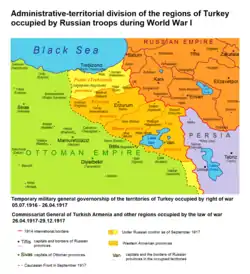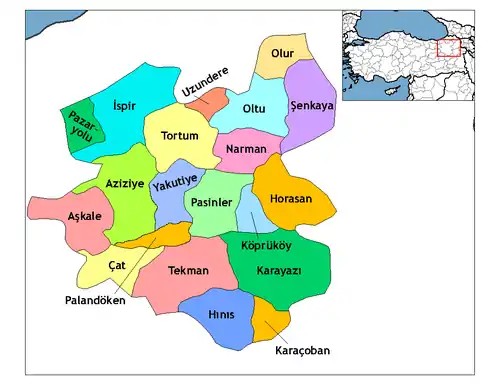Hınıs
Hınıs (Kurdish: Xinûs,[1] Armenian: Խնուս, Khnus) is a town and district of Erzurum Province in the Eastern Anatolia Region of Turkey. The population is 9,792 (as of 2010). Historical monuments in the town include the castle and the Ulu Cami Mosque, said to be built in 1734 by Alaeddin, the bey of Muş.[2] The town is populated by Kurds.[3]

The district, which is 150 km away from Erzurum to the south, that is to Muş, is very close to the Hamurpert Lake, which has an important place in history, with its location close to the Bingöl mountains. The other districts of the province, Karayazı, Karaçoban and Tekman, are the neighboring districts of Hınıs. In addition, the Varto district of Muş is only 50 km from Hınıs. Hınıs is a plain district and Hınıs Plain is one of the most fertile plains of the region. Therefore, agriculture and animal husbandry are the main sources of income in the district. It has the same characteristics as Erzurum in terms of climate and nature. Winters are cold and snowy, and summers are generally cool. In general, it can be said that it is 5-6 degrees warmer than Erzurum Hınıs Haber
Neighbourhoods
- Acarköy
- Akbayır
- Akçamelik
- Akgelin
- Akgöze
- Akören
- Alaca
- Alagöz
- Alikırı
- Alınteri
- Altınpınar
- Arpaderesi
- Aşağı Kayabaşı
- Avcılar
- Bahçe
- Başköy
- Bayır
- Bellitaş
- Beyyurdu
- Burhan
- Çakmak
- Çamurlu
- Çatak
- Çilligöl
- Dağçayır
- Demirci
- Derince
- Dervişali
- Dibekli
- Dikili
- Divanhüseyin
- Elmadalı
- Erbeyli
- Erduran
- Erence
- Esenli
- Göller
- Gülistan
- Güllüçimen
- Gürçayır
- Güzeldere
- Halilçavuş
- Hayran
- Ilıcak
- İsmail
- Kalecik
- Karaağaç
- Karabudak
- Karakula
- Karamolla
- Kazancı
- Ketenci
- Kısık
- Kızılahmet
- Kızmusa
- Kolhisar
- Kongur
- Köprübaşı
- Meydan
- Mezra
- Mollacelil
- Mollakulaç
- Mutluca
- Ortaköy
- Ovaçevirme
- Ovakozlu
- Parmaksız
- Pınar
- Pınarbaşı
- Saltepe
- Sanayi
- Sarılı
- Sıldız
- Söğütlü
- Sultanlı
- Suvaran
- Şahabettin
- Şahverdi
- Şalgam
- Tanır
- Tapu
- Taşbudak
- Tellitepe
- Tipideresi
- Toprakkale
- Toraman
- Uluçayır
- Uyanık
- Ünlüce
- Yamanlar
- Yaylakonak
- Yelpiz
- Yenikent
- Yeniköy
- Yeşilbahçe
- Yeşilyazı
- Yolüstü
- Yukarı Kayabaşı
References
- adem Avcıkıran (2009). Kürtçe Anamnez Anamneza bi Kurmancî (PDF) (in Turkish and Kurdish). p. 56. Retrieved 17 December 2019.
- Sinclair, T.A. (1989). Eastern Turkey: An Architectural & Archaeological Survey, Volume I. Pindar Press. p. 289. ISBN 9780907132325.
- Bajalan, Djene Rhys. "Between Accommodationism and Separatism: Kurds, Ottomans and the Politics of Nationality (1839-1914)". University of Oxford: 186.
{{cite journal}}: Cite journal requires|journal=(help)
